Swing rhythm is more than just a fundamental rhythm technique, it can completely transform a basic track into a groovy, dynamic masterpiece.
It can infuse life into music, produce a captivating listening experience, and significantly enhance a song’s overall feel.
So, as a music producer, understanding this rhythmic style is essential to creating tracks that emotionally stick with your listeners and stand out in a competitive field.
In today’s article we’ll break down:
- The significance & creative use of swing rhythm ✓
- The role of eighth notes in creating swing ✓
- Differences between swing rhythms & straight rhythms ✓
- Characteristics of shuffle rhythm ✓
- Playing with eighth note triplets for that signature swing feel ✓
- Expert techniques to utilizing swing rhythm in your tracks ✓
- Practical tips for producing swing rhythm digitally ✓
- Experimenting with swing in various musical contexts ✓
- Much more about swing rhythms ✓
After reading this article, you’ll be able to understand and use swing rhythm like a pro, creating tracks with that classic swing vibe.
Whether you’re looking to dive into jazz and blues or bring a new twist to modern genres, mastering swing rhythm will open up a world of possibilities.
And the key to getting your music the recognition it deserves is, after all, bringing a unique twist, which this approach can help with.
So, let’s dive in…
Table of Contents
What is Swing Rhythm? Breaking it Down
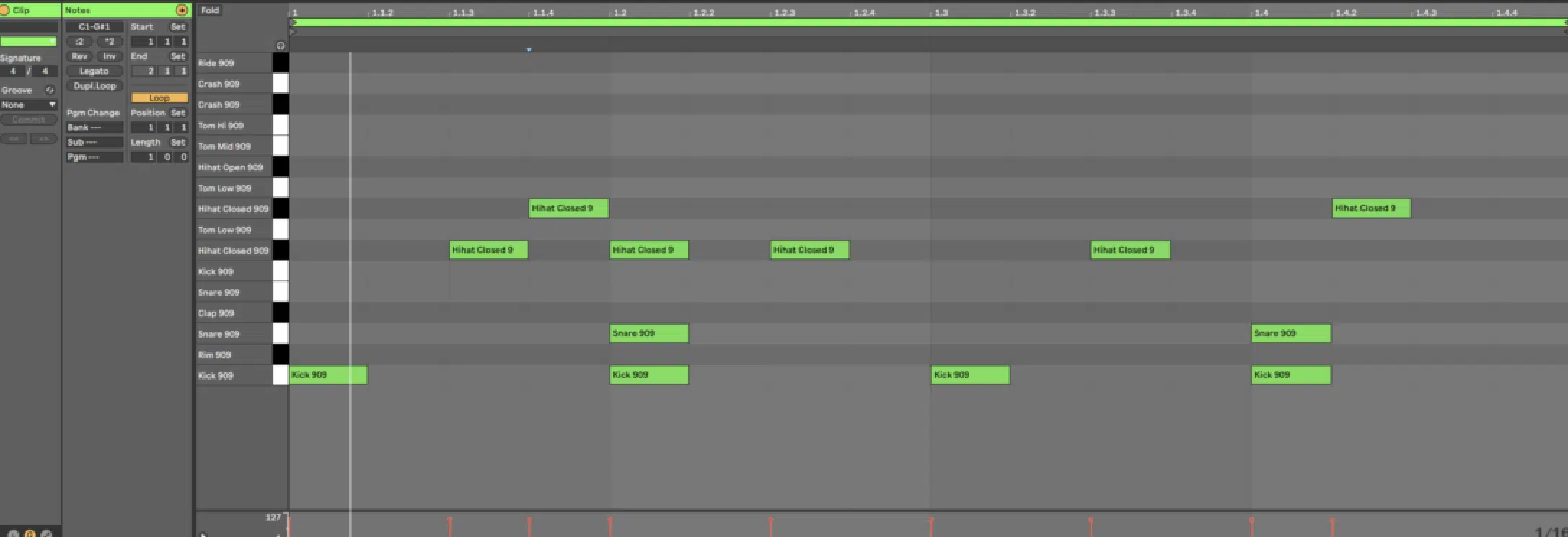
Swing rhythm, a pivotal element in music, especially in genres like jazz and blues, is the essence of groove in many tracks.
As a music producer, understanding and effectively using swing rhythm is an interesting way to create dynamic and engaging music.
Swing rhythm fundamentally changes the timing of beats and notes (particularly eighth notes) creating a syncopated and lively feel.
This rhythm pattern deviates from the even, predictable structure of straight rhythms found in classical music and rock 一 bringing a unique bounce to your music.
Swing rhythm, especially prominent in swing music and jazz, uses an uneven distribution of beats to create its signature sound.
This rhythmical variation is perfect for creating tracks with that toe-tapping quality.
The real charm of swing rhythm lies in its ability to transform simple note sequences into engaging and complex grooves, which we’ll break down throughout the article.
In swing jazz, for example, the rhythm adds fluidity and life, which has a nice yin-yang effect with the more rigid structure of straight rhythms.
As a producer, mastering this concept can immensely elevate the groove and appeal of your tracks in some interesting ways if used correctly.
The Basics of Swing Rhythm
Diving into the basics of swing rhythm can help you understand how it creatively shapes and defines musical genres 一 providing a valuable tool for music production.
-
Understanding Eighth Notes and Swing Rhythm

Eighth notes are the nucleus of swing rhythm, defining that beautiful rhythm we love.
- In a typical straight rhythm, eighth notes are played evenly.
- In swing music, the second eighth note in a pair is played with a delay.
This creates a rhythmic feel that’s distinct from the evenly spaced eighth notes in a straight rhythm.
Let’s take an example from swing jazz…
In a classic jazz standard, the rhythm section might play a series of eighth notes, in straight rhythm, these notes would divide each beat evenly, but in swing, the second eighth note is delayed.
This delay is what gives swing music its unique groove.
In swing rhythm, this manipulation of eighth notes creates what’s known as a ‘swung’ feel, which we’ll break down in the following section.
The delay of the second eighth note in the pair makes the rhythm swing, as opposed to the more mechanical feel of straight rhythm.
This difference is a defining feature of swing music and an essential skill for most jazz musicians and digital music producers.
NOTE: When you practice swing rhythm, focus on the interplay between long notes and short, staccato beats.
Pay attention to the quarter note, as it often anchors the rhythm, and experiment with placing the sixteenth note and the rest in between.
This can add a dynamic feel, especially at faster tempos as opposed to slower tempos.
-
The Role of Swung Eighth Notes

Swung eighth notes are the heart and soul of swing rhythm 一 they give swing music its distinctive, foot-tapping groove.
In swing rhythm, the conventional approach to eighth notes is tweaked, which creates a syncopated rhythm.
This involves playing the second eighth note of a pair with a slight delay, which is the essence of the swing feel.
Yes, I’m going to say it a few times, because it’s the key to mastering this topic.
Using the jazz standard example again, the rhythm section might use swung eighth notes to create a lively, bouncing rhythm that’s fundamental to jazz music.
When these swung eighth notes are played, the second note in the pair is delayed 一 usually falling closer to the next beat.
This delay creates rhythmic tension and release, which is essential in jazz and other genres that utilize swing rhythm.

In digital music production, replicating this swung rhythm can significantly influence the groove of a track.
For example, when programming a drum pattern or a bassline, adjusting the timing of the second eighth note can:
- Transform a rigid, mechanical sequence.
- Turn it into a flowing, dynamic rhythm.
The key to effectively using swung eighth notes lies in the subtle timing variations that define the swing feel.
These swung rhythms, when played correctly, can add depth and a sense of movement to your music, distinguishing it from tracks with straight, even rhythms.
-
Swing Rhythms vs. Straight Rhythms

Understanding the difference between swing rhythms and straight rhythms is mandatory when talking about swing rhythms.
So, let’s break it down a little bit.
- In straight rhythm, notes like eighth notes are played at a regular pace; commonly heard in classical music or pop.
- Swing rhythms, however, delay certain notes (typically the second eighth note in a pair) to create a groovy, dynamic feel.
The straight rhythm, with its evenly spaced eighth notes, creates a predictable, metronomic feel, whereas swing rhythm introduces a syncopated rhythm.
This syncopation in swing rhythms, especially in swing music and jazz, adds that undeniably pleasing quality that straight rhythm lacks.
NOTE: An easy way to distinguish the two is to listen closely to a swing pattern in jazz music and compare it with a straight rhythm pattern in classical music.
The swing rhythm will have a more relaxed feel, especially in how the eighth notes are timed, as opposed to the more regimented timing of straight rhythm.
-
What is a Shuffle Rhythm?
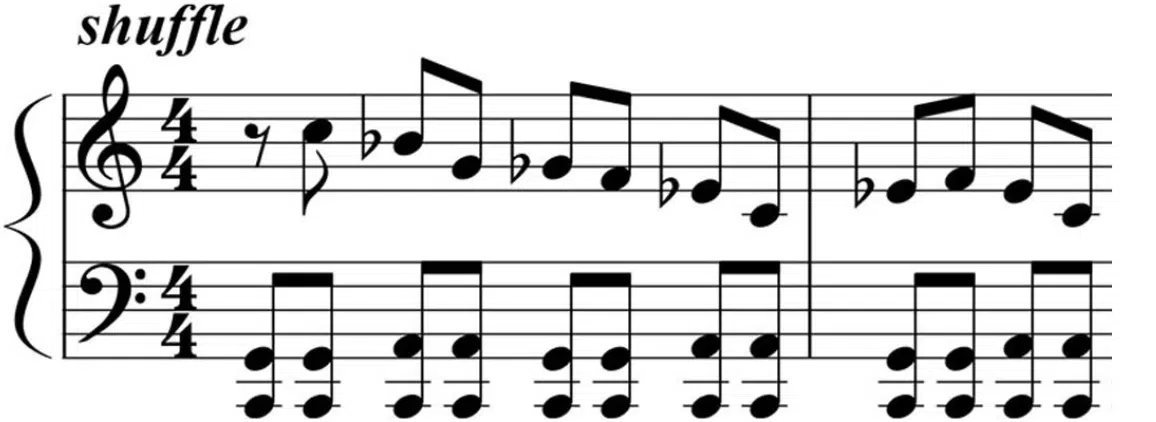
Shuffle rhythm, often heard in rock music, is a derivative of swing rhythm.
It shares the basic principle of delaying the second eighth note but has a more pronounced swing feel.
The shuffle rhythm is integral in creating the danceable, groovy feel typical of blues music.
The key to a shuffle rhythm is in how the eighth notes are played…
Unlike a light swing, the shuffle has a heavier feel, which puts more emphasis on the delayed second eighth note.
This creates a bouncing, rolling rhythm that’s fundamental to the blues genre.
A classic blues tune often uses shuffle rhythm to drive the song.
This rhythm gives the blues its distinctive groovy feel, setting it apart from other genres.
As a music producer, mastering shuffle rhythm can be a powerful tool to have in your back pocket 一 allowing you to impart your beats with a bluesy, rhythmic feel.
Technical Aspects of Swing Rhythm
Exploring the technicalities of swing rhythm in music production can significantly enhance the quality and appeal of your tracks.
-
Playing with Eighth-Note Triplets and Swung Rhythms
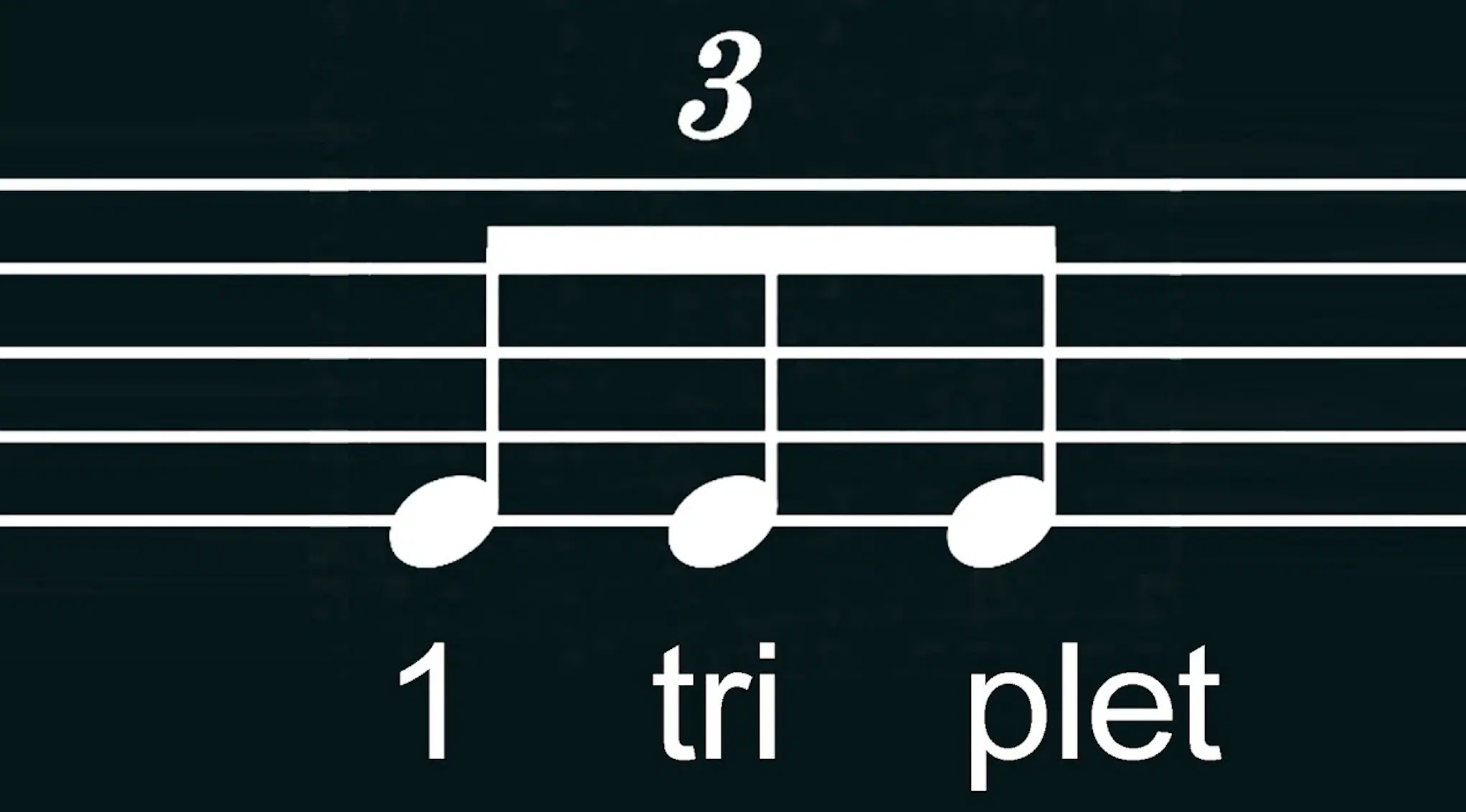
Eighth-note triplets are at the heart of creating a swung rhythm, and in these triplets, each beat is divided into three equal parts.
In swing rhythm, however, you typically play only the first and third notes of the triplet, skipping the middle note.
This creates the distinctive swing feel found in much of jazz music.
In music production, manipulating eighth-note triplets to achieve the right swing feel is a pretty interesting approach.
By adjusting the timing of the second note in the eighth note triplet (usually played as a rest), you can vary the intensity of the swing.
This is crucial for genres like swing jazz or a hybrid, where the swing feel needs to be just right.
A classic example of this in action is in swing jazz, where the ride cymbal often plays a pattern based on eighth-note triplets.
The cymbal will hit on the first and third notes of the triplet 一 creating the swinging rhythm that propels the music.
This technique is a staple for jazz musicians and an important skill if you’re attempting it in your DAW.
-
The Dynamics of Straight Eighth Notes vs. Swung Eighth Notes

The comparison between straight eighth notes and swung eighth notes is also fundamental in understanding the dynamics of swing rhythm.
- Straight eighth notes, played in a consistent and even manner, are the backbone of many musical styles, particularly those that require a predictable rhythm.
- Swung eighth notes, which are integral to swing rhythm, are played with a noticeable delay on the second note 一 creating a distinct rhythmic feel.
If you’re aiming to play swing rhythm, which a lot of modern pop songs are integrating lately, the approach to eighth notes changes dramatically.
Straight eighth notes are played evenly, with each note taking up half a beat in a consistent pattern, resulting in a metronomic feel, common in classical music and rock.
On the other hand, swung eighth notes break this evenness because, again, the first note in a pair of swung eighth notes is held slightly longer and the second note is delayed, falling closer to the next beat.
This timing variation is what gives swing music its characteristic groove.
The choice between straight eighth notes and swung eighth notes can significantly alter the vibe of your track, and this dynamic interplay between straight and swung eighth notes holds a ton of potential.
Understanding when and how to use each type can enhance the rhythmic complexity and appeal of your music.
For example, a drummer in a jazz ensemble might switch between:
- Straight eighth notes during a more structured section of a tune.
- Swing eighth notes during a more fluid, improvisational part.
In a nutshell: When playing straight eighths, the beats are evenly spaced, creating a predictable rhythm, unlike swung eighths where the second eighth note falls off-beat.
Therefore, the music will possess a more danceable groove.
Make sure to listen closely to how these beats interact within the rhythm & practice alternating between straight and swung rhythms to understand their distinct qualities.
Drum Monkey: Your Ultimate Swing Companion
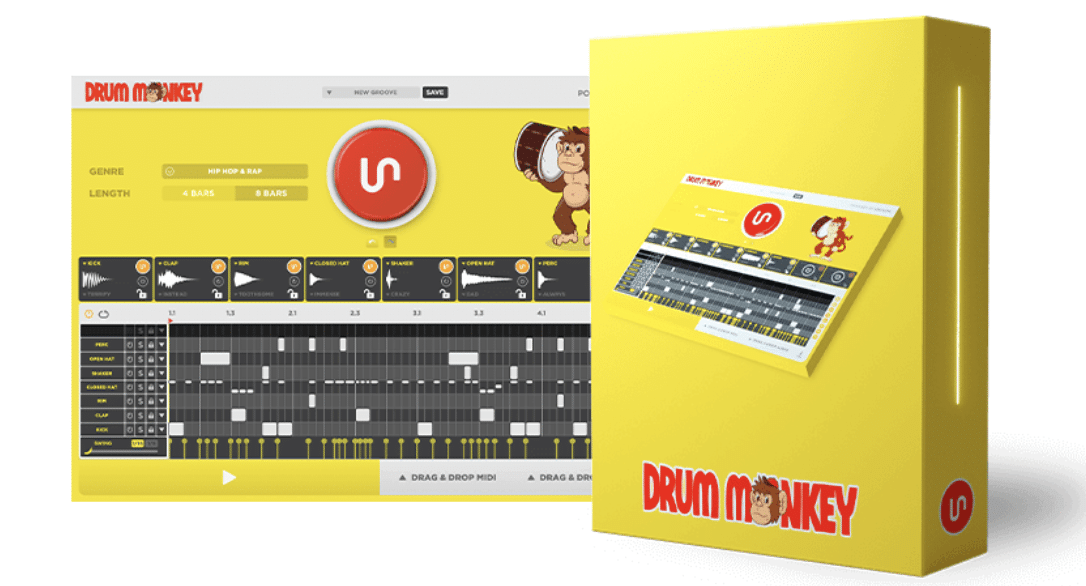
Drum Monkey by Unison Audio is a game-changer for music producers focusing on swing rhythm.
This versatile drum loop generator stands out with its wide range of drum sounds and styles, which makes it perfect for swing music to trap music, and everything in between.
With over 400 drum samples covering all the most popular genres, Drum Monkey offers an immense library to experiment with.
Its user-friendly interface allows producers to quickly create and customize drum beats, adjusting pitch, volume, and more.
Drum Monkey’s capability to handle swing rhythm efficiently makes it an invaluable tool for those looking to play swing rhythm in their tracks.
One of the standout features of Drum Monkey is its Swing parameter, which can help you easily inject that groovy swing feel into your beats.
Whether working on jazz, funk, or even modern genres like pop, this feature provides the flexibility to fine-tune the swing intensity.
Let’s say you wanted to create a drum loop for a jazz/hip-hop hybrid track and needed that classic swung eighth note feel… Drum Monkey can easily deliver.
And, the ability to drag and drop audio and MIDI directly into your DAW streamlines the workflow, making it simpler to integrate these swing rhythms into your music projects.
Drum Monkey is not just about pre-made loops 一 it encourages endless creativity and experimentation.
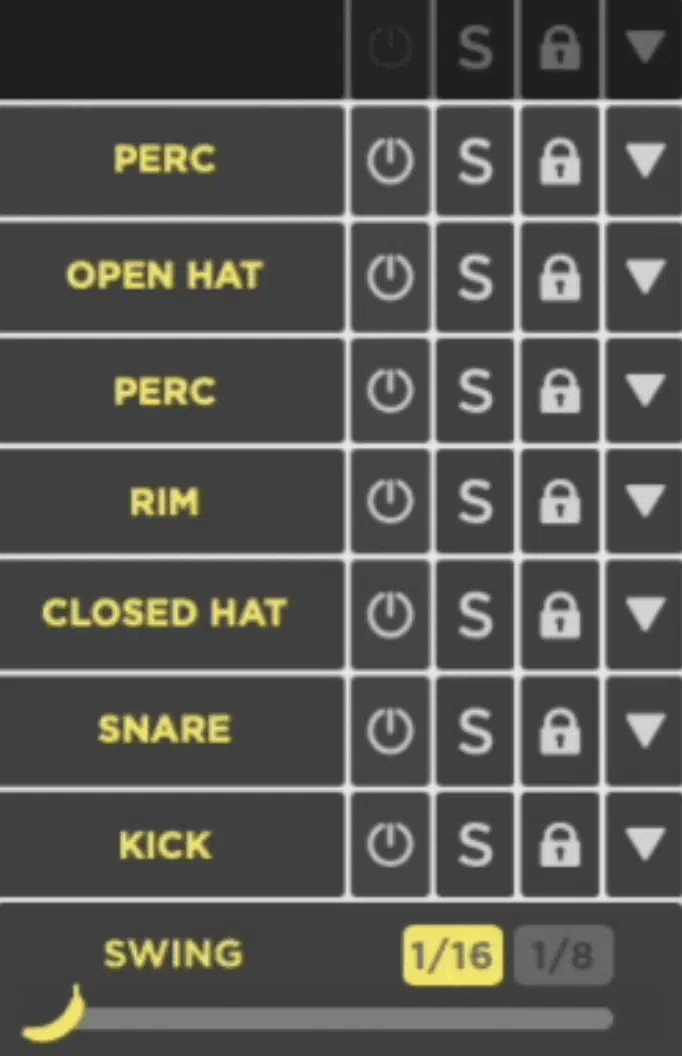
The ability to modify individual drum samples and the arrangement of loops allows you to tailor the swing rhythm to your unique needs.
For instance, if you’re creating a high-energy swing track, you can play with the settings to emphasize the off-beat hits or add a subtle swing to a laid-back jazz joint.
Plus, its processing capabilities (including effects like reverb and distortion) open up more avenues for customization.
This will ensure that your swing rhythms are not just accurate but also sonically rich and engaging; the possibilities are endless!
Tips and Tricks for Producing Swing Rhythm in Digital Music
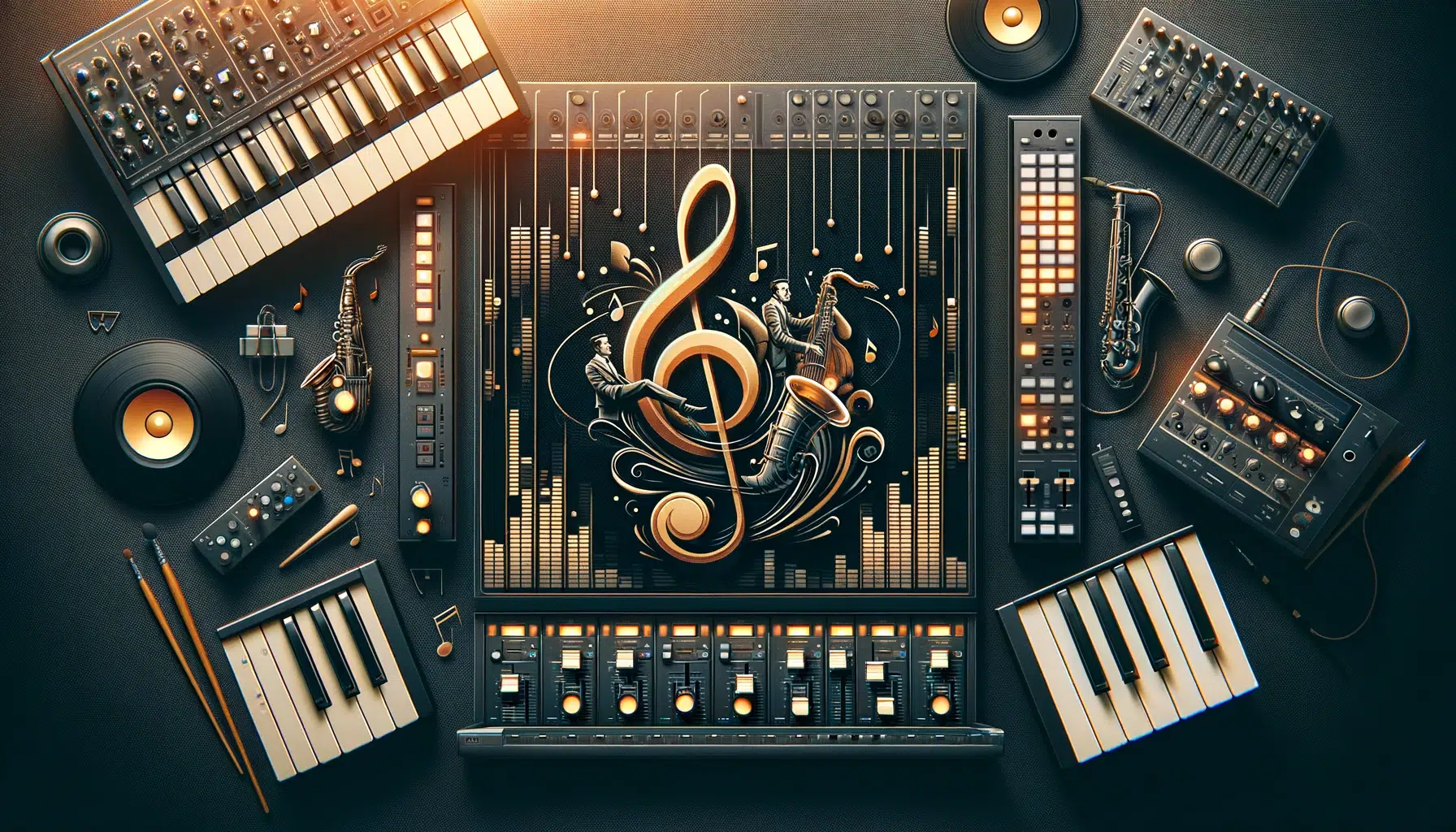
When producing swing rhythm in digital music, it’s important to start with a clear understanding of how swing works.
Using swing or groove templates in your DAW can be a great starting point, but customizing the swing to fit your track is crucial.
One tip is to play around with the timing of your swung eighth notes, as slight variations can have a big impact on the emotions your song is going to produce.
For instance, increasing the delay of the second eighth note can intensify the swing feel, which can be particularly effective in genres like swing jazz or blues.
Another tip is to combine swing rhythms with straight rhythms within the same track, which can create a complex, interesting texture in your music.
For example, you could have a drum pattern playing straight eighth notes while the bassline uses a swing pattern.
This contrast can add depth and interest to your production 一 making it stand out.
NOTE: it’s essential to understand the roles of quarter notes and sixteenth notes in creating the basic beat.
Music notation and sheet music often illustrate these beats in a particular way, emphasizing the main beat and the off-beat.
This is essential for playing swing rhythm effectively.
Experimenting with Time and Groove in Swing Rhythm

Experimentation is pivotal in mastering swing rhythm, so don’t hesitate to explore different timing and groove combinations to discover what best suits your music.
Each genre/track may demand a unique approach to how you learn swing.
Try varying the swing intensity across different sections of your track, like:
- A more pronounced swing in the chorus can enhance its energy.
- A subtler swing in the verses can ensure a smoother flow.
This dynamic variation not only enriches the track’s overall texture and beat quality but also maintains listener engagement.
Layering straight rhythms with swing rhythms can create a rich, complex texture in your music that people will love when they listen to.
It will make them want to get up and dance.
For example, in a jazz piece, a straight rhythm in the bass line combined with a swung rhythm in the melody can add depth and intrigue to your songs.
NOTE: To master swing rhythm, play around with the triplet feel, where the beat is divided into three parts, and experiment with the length of each long note.
This approach helps in understanding how to play swing rhythm, as it emphasizes the subtleties of timing and how beats are spaced within the rhythm.
Swing Rhythm: Final Thoughts
The world of swing rhythm is super intriguing for any music producer looking to create unique and captivating tracks.
This rhythm style, with its unique syncopation and groovy feel, can transform the simplest melodies into engaging and dynamic musical experiences.
By mastering swing rhythms, from the playful dance of swung eighth notes to the intricate patterns of swing and straight rhythms, you open up endless possibilities.
Remember, swing rhythm is more than just a technique 一 it’s a musical language that can speak directly to the listener’s sense of rhythm and movement.
Whether you’re working on jazz, blues, or infusing swing into modern genres like pop, the knowledge and application of swing rhythm will bring a unique quality to your tracks.
So, embrace the swing, experiment with its rhythms, and watch your music come alive with a captivating groove that is impossible to ignore.
Until next time…
The Answer To All Your Swing Rhythm Needs







Leave a Reply
You must belogged in to post a comment.